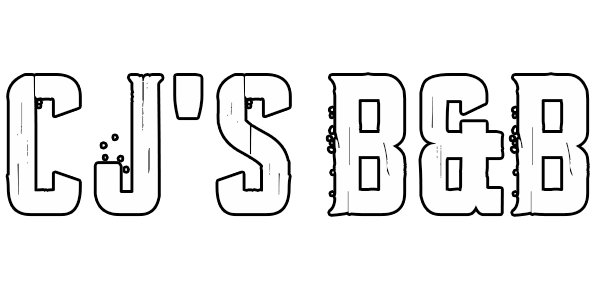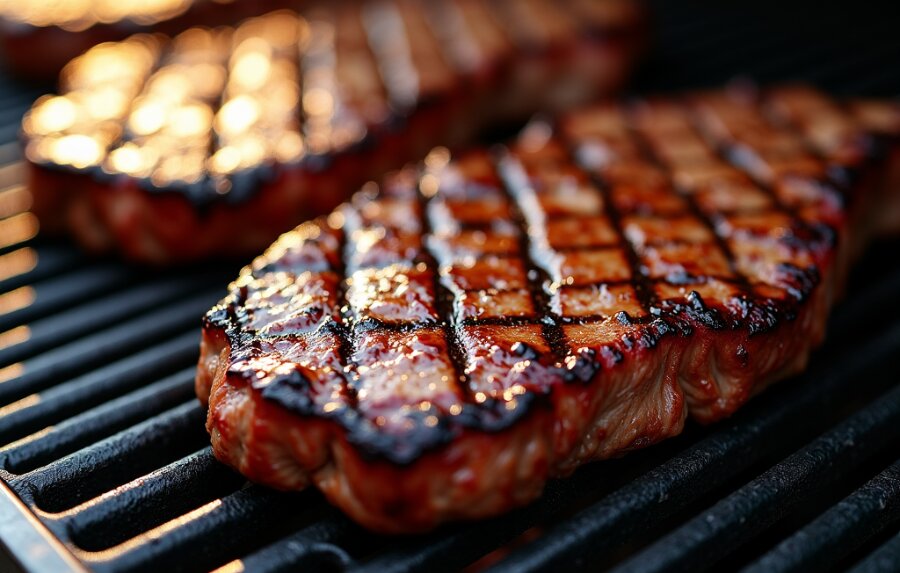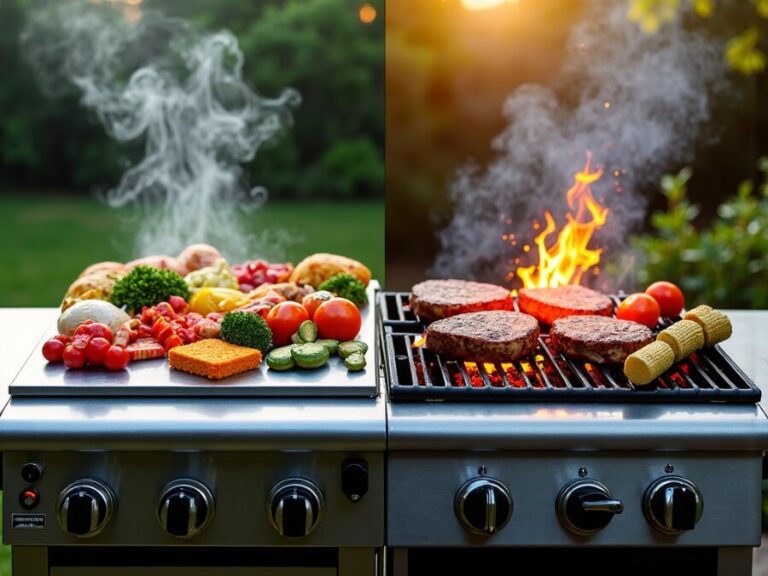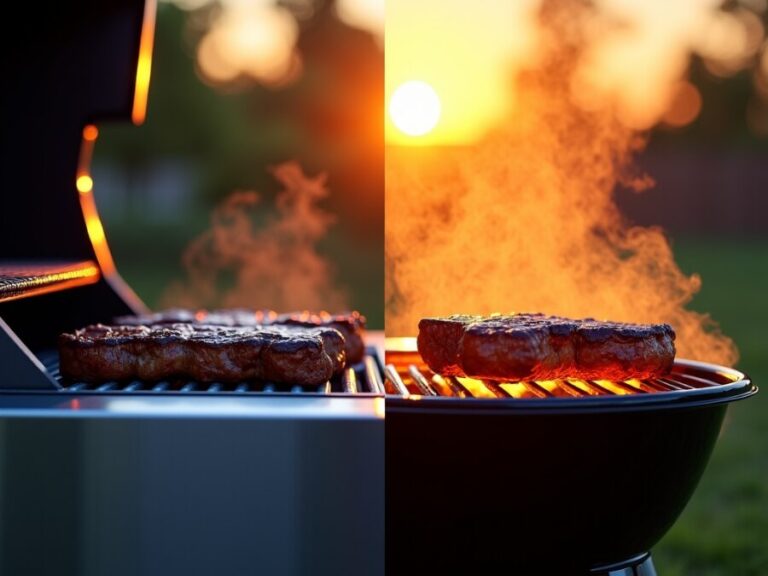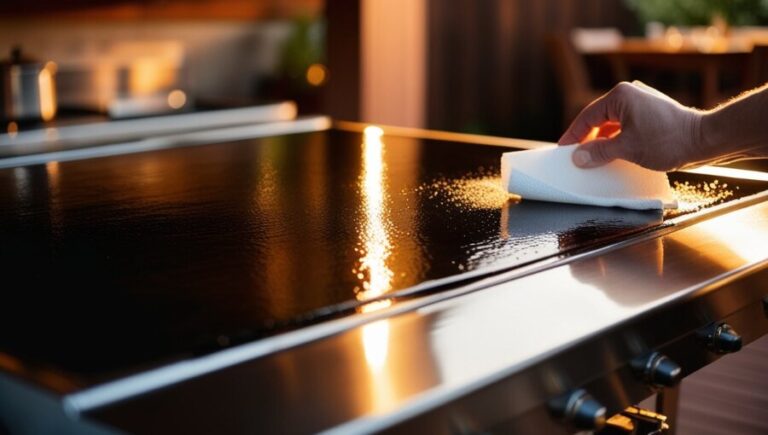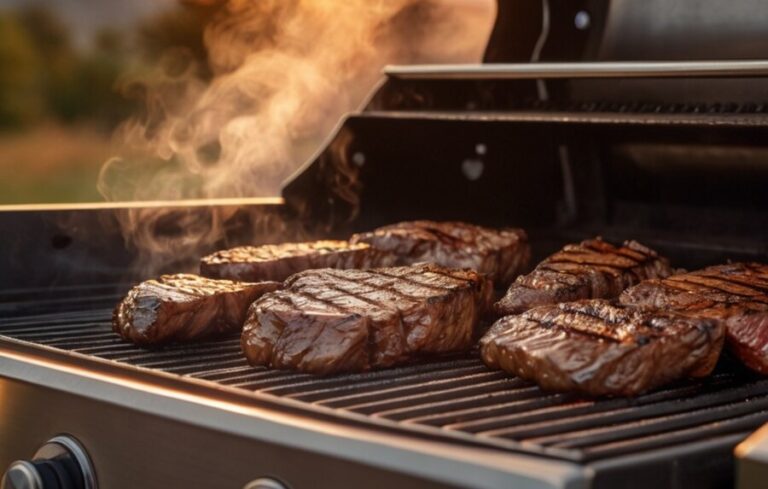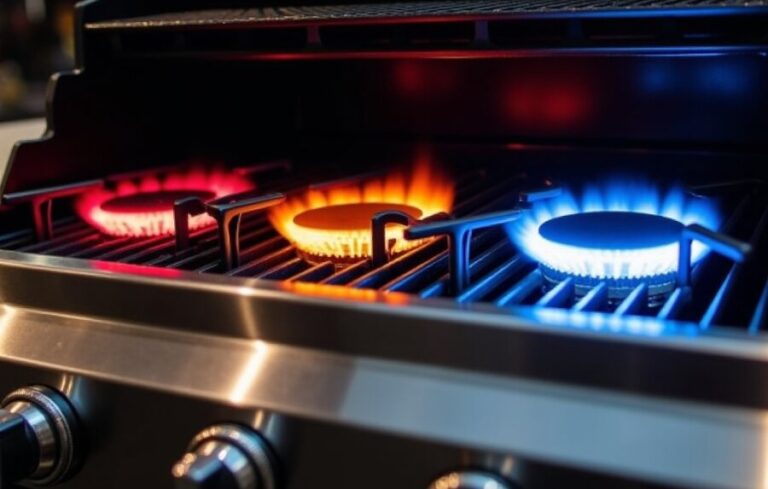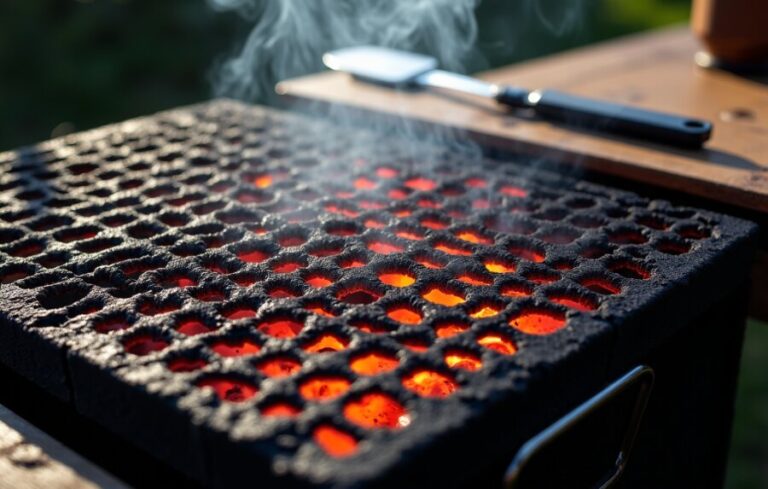Our evaluations and product assessments are conducted using a thorough and unbiased approach. Should you choose to buy any items through our provided links, we might receive a commission Read our disclosures.
Grilling Fuel Sources
Picking the best grill for flavor really comes down to the fuel. The type of charcoal I use can make or break my BBQ. So, let’s talk about the two main kinds: charcoal briquettes and hardwood lump charcoal.
Charcoal Briquettes
Charcoal briquettes are the go-to for many grillers who want consistency and ease. These little guys are made to burn evenly and give you a steady heat. Here’s the deal, though—convenience has a price. Many briquettes are packed with chemicals and additives like lighter fluid. These extras can mess with your food’s flavor, leading to a less-than-pleasant aftertaste (Compact Appliance).
Here’s a quick rundown of charcoal briquettes’ pros and cons:
| Feature | Charcoal Briquettes |
|---|---|
| Flavor Impact | May introduce chemicals |
| Burn Time | Medium (1-2 hours) |
| Temperature Control | Stable but not blazing hot |
| Ash Production | High |
If flavor’s your game, be picky about your briquettes. Look for ones without weird additives.
Hardwood Lump Charcoal
Now, hardwood lump charcoal is where the magic happens. Unlike briquettes, these chunks are all-natural—no weird fillers or chemicals. This makes for a pure, smoky flavor that’s hard to beat. Perfect for everything, from low-n-slow cooking to high-heat searing (Compact Appliance).
Here’s why I love hardwood lump charcoal:
| Feature | Hardwood Lump Charcoal |
|---|---|
| Flavor Impact | Natural, rich flavor |
| Burn Time | Shorter (30 min – 1 hour) |
| Temperature Control | Hotter and more flexible |
| Ash Production | Low |
For me, the natural taste and versatility of hardwood lump charcoal win every time. Whether I’m grilling juicy ribs or experimenting with veggies, this charcoal takes it up a notch.
Curious about choosing between charcoal and gas? Check out our gas vs charcoal grills article for more tips.
Gas Grill Fuel Options
Choosing the right fuel makes a big difference when it comes to grilling. As someone who loves outdoor cooking, I’ve tried both natural gas and propane grills. Here’s what I’ve learned from my experience.
Natural Gas Advantages
Natural gas grills are popular for a good reason. They’re cheap to run and offer an unlimited fuel supply. When I connected my grill to a natural gas line, I loved the convenience. Imagine grilling for hours without worrying about running out of fuel! However, while natural gas is practical, it doesn’t quite match the rich, smoky flavor you get from charcoal Compact Appliance. It just doesn’t have that same BBQ essence.
| Feature | Natural Gas |
|---|---|
| Fuel Availability | Never-ending supply |
| Cost | Easy on the wallet |
| Flavor Impact | Lacks the smoky punch of charcoal |
Propane’s Practicality
Propane is my go-to fuel. Over 98% of gas grills use propane, so it’s super easy to find and pretty cheap too. Propane burns clean, making it versatile and efficient. But like natural gas, propane doesn’t pack as much flavor punch as charcoal Compact Appliance.
One big plus of propane is how quickly I can get the grill hot. Perfect for those sweet grill lines! Just keep in mind that the grill can affect the flavor if it’s not clean House of Coco.
| Feature | Propane |
|---|---|
| Fuel Availability | Easy to find |
| Cost | Budget-friendly |
| Flavor Impact | Not as smoky as charcoal |
Conclusion
Both natural gas and propane have their perks and downsides. If you want a hassle-free setup with a steady fuel supply, go with natural gas. For flexibility and portability, propane is your buddy. Just remember, if you’re all about the flavor, none of the gas options can quite match the magic of charcoal. Check out our guide on gas vs charcoal grills to weigh all your options.

Wood Pellets for Grilling
Introduction to Wood Pellets
Wood pellets have stepped onto the grilling scene, bringing a new twist to barbecue lovers everywhere. They’re made from squished wood shavings or dust and come in all sorts of wood types, so you can mix and match flavors for different meats. Hickory for pork? Yes, please! Applewood for poultry? Absolutely sweet.
These pellets blend the convenience of gas grilling with that rich, smoky goodness usually tied with charcoal. Perfect for gas geeks and charcoal champs alike. Thinking about dabbling in wood pellets? Find your flavor-spreading grill first!
| Wood Type | Flavor Profile | Best For |
|---|---|---|
| Hickory | Strong, bacon-like flavor | Pork, ribs |
| Mesquite | Bold, earthy flavor | Beef, brisket |
| Applewood | Mild, fruity flavor | Poultry, pork |
| Cedar | Subtle, aromatic flavor | Fish |
Need the lowdown on different grills? Hit up our guide on gas vs charcoal grills.
Managing Wood Pellet Storage
Keep your wood pellets dry, or kiss that flavor goodbye. These suckers don’t like moisture one bit. Follow these storage tips to keep those pellets top-notch:
- Dry as a Bone: Store pellets in a cool, dry spot. Sealed containers are your best friends.
- Humidity Be Gone: Don’t leave bags open or they’ll soak up moisture faster than a sponge.
- Basement? Are You Sure?: Storing in a basement or shed? Double-check it’s not damp.
Store ’em right, and you’ll always get that top-tier flavor. Need more grilling wisdom? Check out our gas grill temperature control article for some pro tips.
With wood pellets, you’re not just grilling; you’re taking your taste buds on a wild ride. Whether you’re just starting out or a grill master, these pellets are your golden ticket to flavor town.
Flavor Boosters in Grilling
Alright, let’s talk about how to make your grilled meals taste like a million bucks. It’s not just about throwing a steak on the grill and hoping for the best. Nope, some key ingredients and techniques can really crank up the flavor. Here’s how I keep my grilling game strong, and how you can too!
Spices and Seasonings
The heart and soul of any great grilled dish? The spices and seasonings. Each culture has its own magical blends, and mixing these up can massively up your grill game. Picture this: a marinade packed with olive oil, vinegar, lemon juice, garlic, and an assortment of herbs. Imagine the flavors dancing into every corner of your meat (Penniless Parenting).
Check out this simple yet punchy cheat sheet of marinade ingredients and their vibes:
| Marinade Ingredient | Flavor Vibes |
|---|---|
| Olive Oil | Rich, fruity |
| Vinegar | Tangy, sharp |
| Lemon Juice | Fresh, zesty |
| Garlic | Pungent, earthy |
| Herbs (like basil, rosemary) | Aromatic, herbaceous |
Playing around with these ingredients lets you mold the flavor to your taste. Mix and match till it sings just right.
Wood Chips Magic
Adding wood chips is like giving your grill a megaphone. Each type of wood brings its own smoky voice, perfect for different kinds of meat and veggies. Say you want a bold, robust flavor—hickory is your go-to. Looking for something sweeter and gentle? Applewood’s got you covered. (Penniless Parenting).
Here’s a quick-and-dirty guide to wood chips and what they bring to the table:
| Wood Type | Flavor Vibes | Best For |
|---|---|---|
| Hickory | Strong, hearty | Pork, ribs |
| Mesquite | Intense, earthy | Beef, lamb |
| Applewood | Light, sweet | Poultry, fish |
| Cherrywood | Fruity, versatile | Any meat, especially pork |
Using wood chips or chunks adds a smoky layer of complexity, taking your food to the next level (PBS).
Throw in some experimentation with spices, marinades, and wood chips, and you’ll be the grill master in no time. Whether you’re rocking a gas grill or a charcoal grill, each has its perks and adds to that epic grilling experience. Happy grilling, folks!
Enhancing Flavor Techniques
Grilling isn’t just cooking; it’s crafting a symphony of tastes and smells. The methods I use can seriously up your flavor game, with marinating and trying out unique grilling techniques being total standouts.
Why Marinating Rocks
Marinating is like flavor magic. Letting meat soak in a mix of liquids and spices before grilling can transform it into something extraordinary. You’ll often find me tossing together olive oil, vinegar, lemon juice, herbs, and spices. This not only amps up the taste, but also makes the meat tender and juicy.
Here’s a cheat sheet for whipping up killer marinades:
| Ingredient | What It Does |
|---|---|
| Olive Oil | Adds richness and moisture |
| Vinegar | Tenderizes, adds a kick |
| Lemon Juice | Citrusy zing |
| Herbs (e.g., basil) | Fresh and aromatic |
| Spices (e.g., paprika) | Deep, smoky notes |
For juicy details on grills, check out my thoughts on gas vs charcoal grills.
Fun Ways to Grill
Beyond marinating, I love messing around with different grilling tricks to give my food a serious flavor boost. Cooking directly on hot coals, for instance, gives you that smoky intensity that’s a game-changer.
Another trick up my sleeve is using a Himalayan salt block. It adds a subtle salinity plus a mineral twist that fits perfectly with natural food flavors. Here’s a quick rundown of some radical grilling methods:
| How to Grill | Flavors You’ll Get |
|---|---|
| On Hot Coals | Deep, smoky goodness |
| Himalayan Salt Block | Salty, mineral notes |
| Wood Chips | Extra woody, earthy vibes |
These hacks can totally level up your grilling game, making it thrilling and tasty every time. Hungry for more grilling wisdom? Swing by for some gas grill tips and see why charcoal grills rock.
Grill Types & Flavor Impact
Grilling aficionados know that the type of grill you choose can make all the difference in flavor. Here, I’ll break down what you can expect from charcoal and gas grills so you can get the best taste from your BBQ.
Charcoal Grill Characteristics
Charcoal grills, such as the well-known Weber models, are the go-to for rich, smoky flavors. They run on charcoal briquettes or hardwood lump charcoal, each offering its own perk. Briquettes are all about consistency and ease, though they might sometimes add a chemical tinge to your food due to their make-up.
Meanwhile, hardwood lump charcoal is the purist’s choice—with no sneaky additives, it grants a more genuine taste, ideal for those slow-cooked ribs or high-heat steak searing sessions.
| Charcoal Type | Flavor Profile | Temperature Range |
|---|---|---|
| Charcoal Briquettes | Can add a subtle chemical taste | 500 – 700°F (260 – 371°C) |
| Hardwood Lump Charcoal | Pure, rich flavors | 200 – 700°F (93 – 371°C) |
Using a charcoal grill is like a labor of love; it takes time to heat up and demands attention to avoid overcooking or accidental charring. But the reward? Mouthwatering, savory goodness straight from the flames that keeps grill masters coming back.
Gas Grill Flavors
Gas grills are all about ease and speed. They deliver consistent heat and are perfect for those spontaneous weeknight BBQs. The flavor can vary big time based on how you cook. Whether you’re grilling over an open flame or using a rotisserie, your taste buds will notice.
One standout feature of gas grills is their precise temperature control. With adjustable burners, holding the perfect heat is a breeze. Typically, gas grills run cooler than charcoal ones, meaning your food will have a different, often lighter texture and taste.
| Cooking Method | Flavor Profile | Temperature Range |
|---|---|---|
| Direct Cooking | Light, mildly smoky taste | 500 – 700°F (260 – 371°C) |
| Indirect Cooking | Juicy, tender, subtly smoky | 200 – 300°F (93 – 149°C) |
Though gas grills don’t pack as much charred punch as charcoal, they can still deliver scrumptious results, especially when you get creative with herbs, spices, and marinades. This makes them a great choice for both newbies and seasoned grillers keen on exploring different flavor mixes.
Picking Your Grill
Deciding between gas and charcoal really depends on what you crave and how you like to cook. Charcoal grills give you that layered smoky depth, while gas grills offer quick, controlled, and cleaner cooking. Both promise to elevate your BBQ game, making every cookout session a delightful experience. So, think about what suits your style and taste, and you’ll be well on your way to grilling glory.

